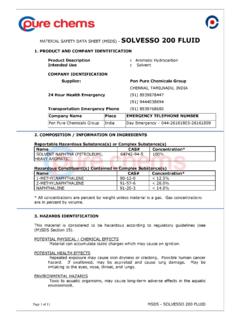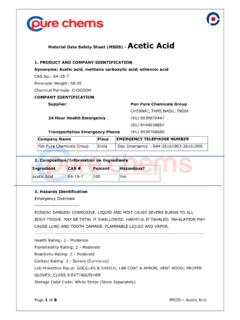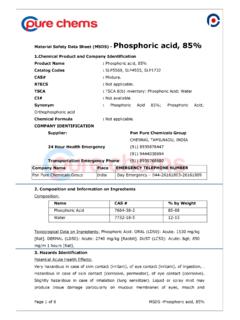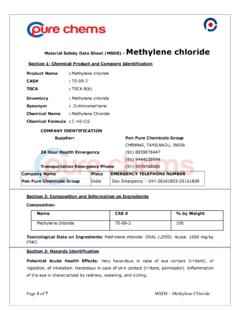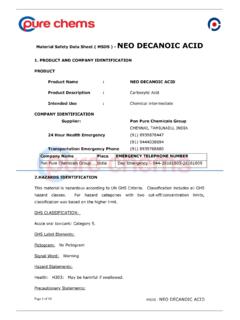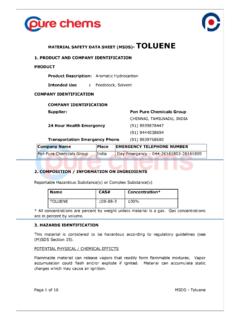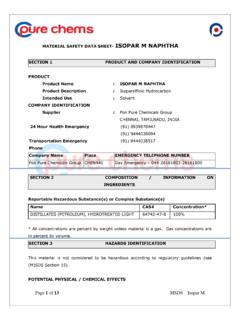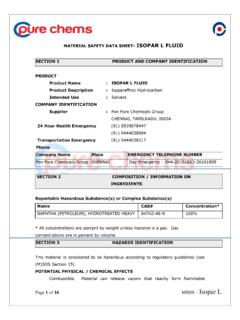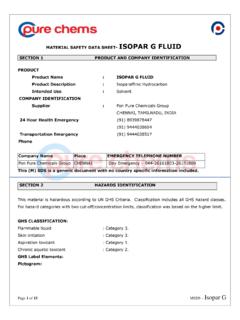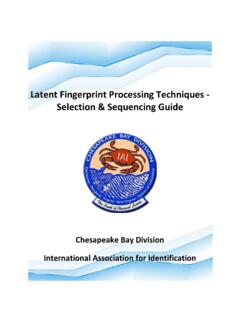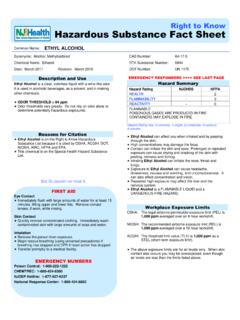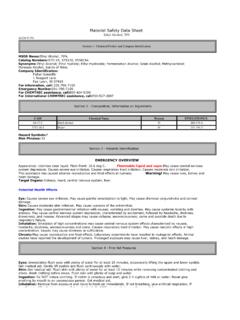Transcription of Material Safety Data Sheet (MSDS) - Caustic Soda Section 1 ...
1 Page 1 of 8 msds Caustic Soda Material Safety Data Sheet ( msds ) - Caustic Soda Section 1: Chemical Product and Company Identification Product Name : Caustic Soda CAS# : 1310-73-2 TSCA : TSCA 8(b) inventory: Sodium hydroxide CI# : Not available. Synonym : Sodium Hydroxide Chemical Formula : NaOH COMPANY IDENTIFICATION Supplier: Pon Pure Chemicals Group CHENNAI, TAMILNADU, INDIA 24 Hour Health Emergency (91) 8939878447 (91) 9444038694 Transportation Emergency Phone (91) 8939768680 Company Name Place EMERGENCY TELEPHONE NUMBER Pon Pure Chemicals Group India Day Emergency 044-26161803-26161809 Section 2: Composition and Information on Ingredients Composition: Name CAS # % by Weight Sodium hydroxide 1310-73-2 100 Toxicological Data on Ingredients: Sodium hydroxide LD50: Not available.
2 LC50: Not available. Section 3: Hazards Identification Potential Acute Health Effects: Very hazardous in case of skin contact (corrosive, irritant, permeator), of eye contact (irritant, corrosive), of ingestion, of inhalation. The amount of tissue damage depends on length of contact. Eye contact can result in corneal damage or blindness. Skin contact can produce inflammation and blistering. Inhalation of dust will produce irritation to gastro-intestinal or respiratory tract, characterized by burning, sneezing and coughing. Severe over-exposure can produce lung damage, choking, unconsciousness or death. Inflammation of the eye is characterized by redness, watering, and itching.
3 Skin inflammation is characterized by itching, scaling, reddening, or, occasionally, Page 2 of 8 msds Caustic Soda blistering. Potential Chronic Health Effects: CARCINOGENIC EFFECTS: Not available. MUTAGENIC EFFECTS: Not available. TERATOGENIC EFFECTS: Not available. DEVELOPMENTAL TOXICITY: Not available. The substance is toxic to lungs. Repeated or prolonged exposure to the substance can produce target organs damage. Repeated exposure of the eyes to a low level of dust can produce eye irritation. Repeated skin exposure can produce local skin destruction, or dermatitis. Repeated inhalation of dust can produce varying degree of respiratory irritation or lung damage.
4 Section 4: First Aid Measures Eye Contact: Check for and remove any contact lenses. In case of contact, immediately flush eyes with plenty of water for at least 15 minutes. Cold water may be used. Get medical attention immediately. Skin Contact: In case of contact, immediately flush skin with plenty of water for at least 15 minutes while removing contaminated clothing and shoes. Cover the irritated skin with an emollient. Cold water may be used. Wash clothing before reuse. Thoroughly clean shoes before reuse. Get medical attention immediately. Serious Skin Contact: Wash with a disinfectant soap and cover the contaminated skin with an anti-bacterial cream.
5 Seek medical attention. Inhalation: If inhaled, remove to fresh air. If not breathing, give artificial respiration. If breathing is difficult, give oxygen. Get medical attention immediately. Serious Inhalation: Evacuate the victim to a safe area as soon as possible. Loosen tight clothing such as a collar, tie, belt or waistband. If breathing is difficult, administer oxygen. If the victim is not breathing, perform mouth-to-mouth resuscitation. WARNING: It may be hazardous to the person providing aid to give mouth-to-mouth resuscitation when the inhaled Material is toxic, infectious or corrosive. Seek immediate medical attention. Ingestion: Do NOT induce vomiting unless directed to do so by medical personnel.
6 Never give anything by mouth to an unconscious person. If large quantities of this Material are swallowed, call a physician immediately. Loosen tight clothing such as a collar, tie, belt or waistband. Serious Ingestion: Not available. Section 5: Fire and Explosion Data Flammability of the Product : Non-flammable. Auto-Ignition Temperature : Not applicable. Flash Points : Not applicable. Page 3 of 8 msds Caustic Soda Flammable Limits : Not applicable. Products of Combustion : Not available. Fire Hazards in Presence of Various Substances: of metals Explosion Hazards in Presence of Various Substances: Risks of explosion of the product in presence of mechanical impact: Not available.
7 Risks of explosion of the product in presence of static discharge: Not available. Slightly explosive in presence of heat. Fire Fighting Media and Instructions: Not applicable. Special Remarks on Fire Hazards: sodium hydroxide + zinc metal dust causes ignition of the latter. Under proper conditions of temperature, pressure and state of division, it can ignite or react violently with acetaldehyde, ally alcohol, allyl chloride, benzene-1,4-diol, chlorine trifluoride, 1,2 dichlorethylene, nitroethane, nitromethane, nitroparaffins, nitropropane, cinnamaldehyde, 2,2-dichloro-3,3-dimethylbutane. Sodium hydroxide in contact with water may generate enough heat to ignite adjacent combustible materials.
8 Phosphorous boiled with NaOH yields mixed phosphines which may ignite spontanously in air. sodium hydroxide and cinnamaldehyde + heat may cause ignition. Reaction with certain metals releases flammable and explosive hydrogen gas. Special Remarks on Explosion Hazards: Sodium hydroxide reacts to form explosive products with ammonia + silver nitrate . Benzene extract of allyl benzenesulfonate prepared from allyl alcohol, and benzene sulfonyl chloride in presence of aquesous sodium hydroxide, under vacuum distillation, residue darkened and exploded. Sodium Hydroxde + impure tetrahydrofuran, which can contain peroxides, can cause serious explosions. Dry mixtures of sodium hydroxide and sodium tetrahydroborate liberate hydrogen explosively at 230-270 deg.
9 C. Sodium Hydroxide reacts with sodium salt of trichlorophenol + methyl alcohol + trichlorobenzene + heat to cause an explosion. Section 6: Accidental Release Measures Small Spill: Use appropriate tools to put the spilled solid in a convenient waste disposal container. If necessary: Neutralize the residue with a dilute solution of acetic acid. Large Spill: Corrosive solid. Stop leak if without risk. Do not get water inside container. Do not touch spilled Material . Use water spray to reduce vapors. Prevent entry into sewers, basements or confined areas; dike if needed. Call for assistance on disposal. Neutralize the residue with a dilute solution of acetic acid.
10 Be careful that the product is not present at a concentration level above TLV. Check TLV on the msds and with local authorities. Section 7: Handling and Storage Precautions: Keep container dry. Do not breathe dust. Never add water to this product. In case of insufficient ventilation, wear suitable respiratory equipment. If you feel unwell, seek medical attention and show the label when possible. Avoid contact with skin and eyes. Keep away from incompatibles such as oxidizing agents, reducing agents, metals, acids, alkalis, moisture. Page 4 of 8 msds Caustic Soda Storage: Keep container tightly closed. Keep container in a cool, well-ventilated area.
